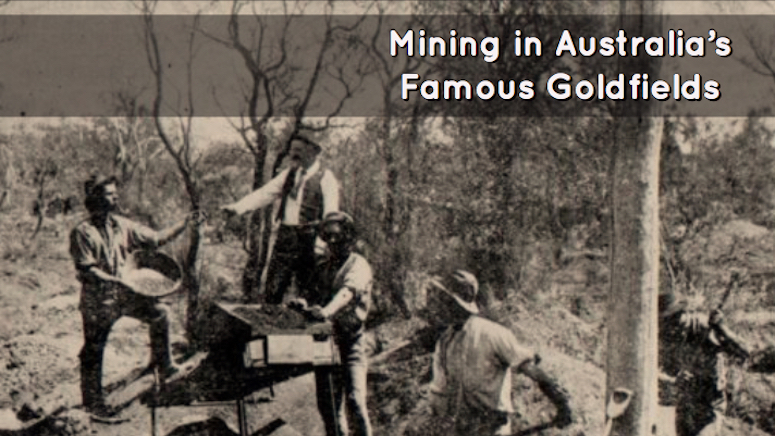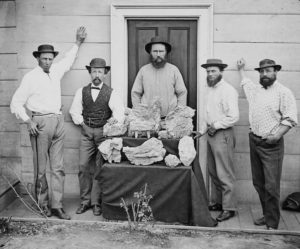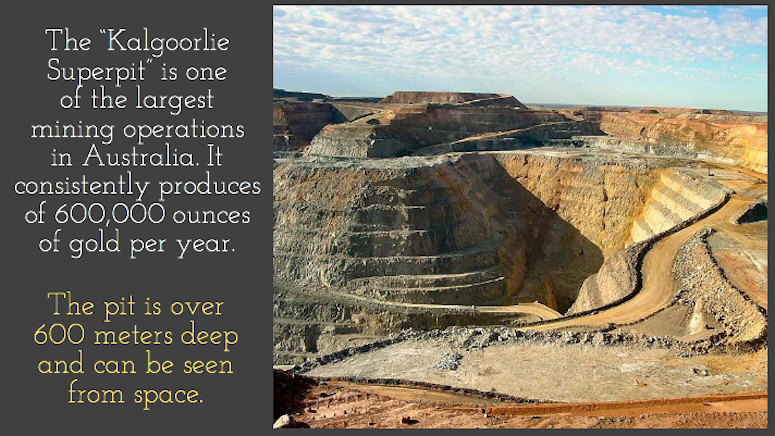
Australia is ranked as the third largest gold producing nation in the world and has a gold mining history that is rich with intrigue and diversity. Gold is Australia was first found in New South Wales in the year 1823. Thereafter, there had been erratic discoveries of traces of gold for several years in New South Wales before the gold rush.
Gold mining in the country took off properly after the discovery of rich reserves of payable alluvial gold at a place called Ophir in New South Wales in 1851, and later in Victoria, particularly at Bendigo and Ballarat.
The 1850s marked the onset of a gold rush that put Australia’s gold mining industry on the world map. The gold rushes led to the Australian colonies being world famous for mining. As news about the gold rush in Australia spread, gold-seekers from other nations around the world began to emigrate to the colonies.
The World Rushes to the Aussie Goldfields
The influx of gold workers from other regions within Australia and immigrants from overseas led to growth in population in Australia, especially in the areas where gold had been found. In just about twenty years from 1851, the total population of Australia had more than tripled.
These gold-seekers came with new professions, skills and cultures, which changed the course of the country’s history. During this period, Australia grew into a multicultural society. Even the diggers who didn’t find wealth on the goldfields stayed and integrated into the Australian communities.
Moreover, the gold rush resulted in an increase in the country’s industrial and agricultural development. This resulted in a burgeoning economy and even more money for gold mining investment.
By the 1850s, 40% of the gold in the world was being produced by Australia, particularly Victoria, which became a center for Australia’s gold mining for several years afterwards. In general, the Australian gold rushes significantly expanded the population in Australia, boosted its economy, and resulted in the advent of a new and unique national identity. The once convict colonies changed to become diverse progressive cities.
Australia’s Gold: The Good and the Bad

One of the few existing pictures of the Golden Eagle Nugget before it was melted down. It was found in Western Australia and weighed 95 pounds!
Before the gold rush in the 1850’s, Australia was fairly virgin. The native Australian communities had harmoniously existed with the land for decades, with only minor disturbance since the settlement of the Europeans. However, emergence of the gold rush led to the rapid destruction of the ecosystems, putting intense pressure on the natural flora and fauna.
In the 1800’s, very little concern was given to the impact of gold mining on the environment. Many trees and bushes along banks were violently and rapidly invaded and cleared away, clean water sources were polluted and many miles of the landscape torn up. The diggers, including the newcomers, were far too focused on the search for gold to be concerned with their negative impact on the environment.
After the landscape was ravaged by the diggers and rendered barren, they would move on to another site and the process was repeated. This led to immense ecological disturbance and a rise in many environmental problems such as salinity, decline in water quality, soil erosion, and extinction of native animals.
Read: The Monsters of the Goldfields – Bucket Line Dredges
Gold Plays a Major Role in the Development of Australia

The Star of Hope Mine in New South Wales produced some of the largest gold specimens in Australia’s history. These massive chunks of gold in quartz would be valued in the millions of dollars today.
Many new inland townships were build and flourished around the mines throughout the country. Most of these gold towns started growing along creek valleys and rivers as sprawling ‘tent cities’ where prospectors constructed simple dwellings or as wayside stops on the way to the gold fields. Profitable areas with flowing income then developed rapidly to new townships.
Even after the first gold rush between 1851 and 1871, some gold field towns still continued to grow through diversification of their mining. For instance, unlike some other gold towns in Australia, the fertile land in Victoria was a natural advantage since it provided many people with a continuous supply of agricultural, timber and pastoral resources. Therefore, it dominated Australia’s economic as well as political life.
Mining Expands Across the Country
Gold mining continues to be a key aspect of the Australian mining industry. It has moved rapidly from alluvial sources and fossicking in the 1850’s to the hard rock mining currently being practiced. Unlike the early prospectors who used picks and shovels to find the initial signs of Australia’s gold deposits, the ingenious exploration methods and latest technology used occasionally leads to the finding of massive lodes of gold missed by early diggers.
Boddington Gold Mine that is located in Western Australia is currently the country’s largest gold mine. Other large gold mines include Kalgoorlie Superpit Gold Mine in Western Australia, Telfer Gold Mine in Western Australia, Jundee Gold Mine in Western Australia, and Lake Cowal Gold Mine in New South Wales. These are massive operations that produce millions of dollars worth of gold each year.

Gold is ranked third among the largest mineral exports in Australia and it is generally the sixth biggest export earner. Australia is also the second largest producer of gold globally after China and has 16.3% of known gold resources in the world, which is the largest share globally.
Australia is, therefore, a key player in the gold industry globally and contributes largely to the global trade of gold with exports of over $16 billion yearly. Three times as much gold is mined annually as was produced in the most productive years of the 1850s.
The Australian gold rush has never really ended. With many tons of gold mined annually and the presence of colossal known gold reserves, there is an assurance in the future of gold in this country.
Next: The 3rd Largest Gold Nugget – Now on Public Display
Also Read: Gold Prospecting in Queensland
